By D. Fisher -- 1900
Back to previous section -- Return to Table of ContentsCHAPTER 17
The Railway and the Power-Plant
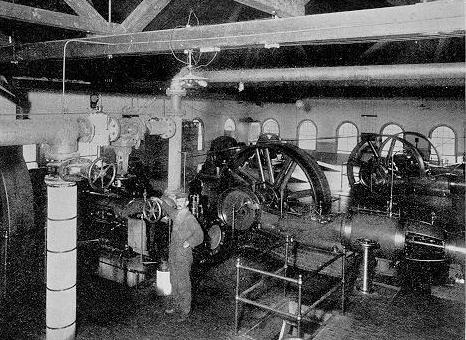
Exeter Road, Hampton
The headquarters of the company are in Folsom's block, on Water street, Exeter. Here are finely-arranged offices for the superintendent and the bookkeepers, and also a large private office for the use of the officials of the company, and a commodious waiting-room for passengers.
Here, also, is kept a large and complete stock of electrical supplies of all kinds, for sale, as well as for the company's use. The Western Union Telegraph Co. have an office in a part of the waiting-room.
There is also an office and large waiting-room on Market square, in Amesbury.
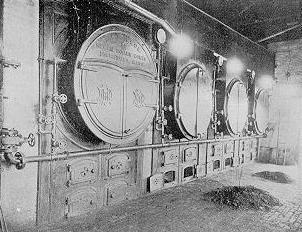
The power-station and plant is centrally located in Hampton, about two and a half miles from the junction, on the line to Exeter. The power building is of brick, and is 100 feet by 80 feet on the ground. It is divided by fireproof walls into the boiler-room, the power-room and the pump and condenser-room.
In the boiler-room, are four 72 inch by 18 feet tubular boilers of the best construction. All the feed water connections are so arranged that any one boiler can be fed, independently of the others, with either heated or cold water. Two of these boilers are in daily use for the railway, and one is added when the lights are put on. The fourth one is an auxiliary to be used in case of need. In the power-room are three 185 horse-power, high speed, Buckeye engines, of 15 1/4-inch cylinder, and 24-inch stroke. When doing regular service they are run at 160 revolutions per minute. Two of these are used for the car service, the third one for lighting service, and is run from 4 p.m. to 12 midnight. The car service engines run two Keystone generators, each of 125 kilowatts and 550 volts. Of course every one who reads this will know exactly what these terms mean. The light service engine has a generator of 2,300 volts, for the incandescent lights, and one of 4,000 volts for the arc lights, of which eighty are used in Exeter. These engines drive the generators by means of belts.

In addition there has been put in place a new Cross compound condensing engine of 400 horse-power. The high pressure cylinder is 16 1/2-inch diameter by 30-inch stroke, and the low pressure cylinder is 30 1/2-inch diameter by 30 inch stroke. The engine is directly connected with its generator. That is to say, no belts are used. The generator is of 250 kilowatts and 550 volts, This compact and powerful engine and generator is to be regarded as one machine. It is constructed so that it can be run by either one of the cylinders, if, from any cause, the other becomes disabled. This engine was put in as an auxiliary power to the two service engines, and will be used in case of accident, or on heavy traffic days to assist the two regular engines.

The heater for the feed water, the condenser, the duplicate feed pumps, and the fire pump of 1,000 gallons per minute capacity, are in the fireproof pump room.
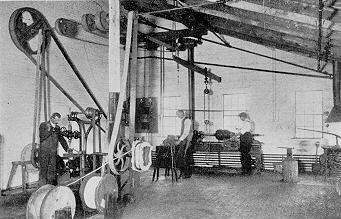
In the power-room there is a steam gauge that registers the pressure for every hour the boilers are in use, and also one showing the present pressure. The switchboards are a mystery to all but the skilled electrician. By meters the engineer knows how much power his machines are producing, and by ammeters he can tell how much is being used on any one of each of his three circuits. In an instant he can light streets, stores, and dwellings miles away, or at a touch leave them all in darkness, or he can stop every car on the whole line, and then as quickly set them all in motion. He can produce, measure, and direct this force, and yet of its whence or why, he knows just as much as everybody else.
The car barn is of wood, and is 215 feet long by 50 feet wide. There are four tracks for cars, of which it can shelter twenty-four at one time. In it are six pits with cemented bottoms and brick sides. These are used in cleaning and repairing the running machinery under the car floor. Forty-eight feet of floor in front is of cement. Here the cars are washed. At the rear of the building is the large repair shop and stock room. It is separated from the room in front by a fireproof wall. Even the door is arranged so as to close automatically in case of a fire. The repair shop is equipped with a powerful motor and with numerous lathes, drills, and other machinery for use in making any needed repair. A large stock of duplicate parts and material is kept on hand.
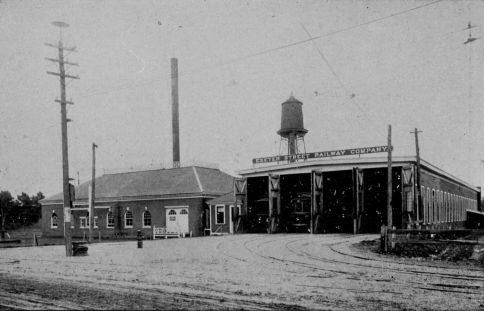
The car barn at Amesbury is of brick and in size and arrangement a duplicate of the one in Hampton, except that there is no repair shop attached. All except minor repairs will be done at the Hampton shop.
At this time of writing there are twenty-six passenger cars of all styles, two flat cars, and one box car for freight, and four powerful Taunton snow-plows. Among the passenger cars are six fourteen-seat, eight wheel, summer cars, equipped with powerful air brakes. These move with the speed and steadiness of a passenger car on a steam railroad. At each side, by each seat, is an electric push button, by which the passenger can notify the conductor that he may stop the car. The company have three more of these cars being built. Another style is that of a combined summer and winter vestibuled car. It will carry thirty-two people, has neat cane seats, and is of a very pretty design. Ordinarily it looks like a dainty summer car. In case of storm or wind, large sash and panels are pulled from mysterious and unnoticed recesses, the running boards are turned up, and in less than the telling of it, the passengers are in a comfortable winter. car. It is provided with a number of colored electric lights, and can be quickly decorated with flags and bunting. It is intended for the use of clubs and trolley parties.
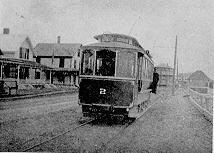
All of the cars of this company were made by the Briggs Car Company of Amesbury, and all passenger cars are provided with safety fenders.
Between the different terminals, there are over twenty-eight miles of track laid with the heaviest steel rails. The track is ballasted in the best manner. It would carry any railroad train. First class chestnut poles carry the wires, and none but the best materials and fittings of the latest styles has been used in any part of the road. Telephones have been placed in all of the offices, at the terminals, and at every turn-out. Indeed it has been the distinct purpose of the management to make their road a model one in every respect.
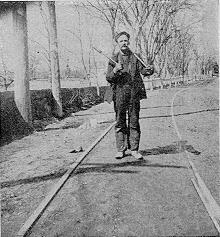
Already the line has become a regular mail carrier, and it now looks as if parcel delivery would soon be added. It will not be the superintendent's or the employees' fault if every patron of this model electric railway is not pleased with the service rendered.
